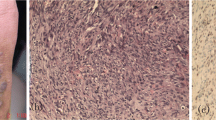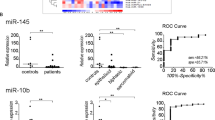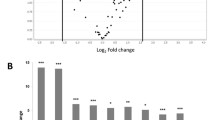Abstract
Merkel cell polyomavirus (MCV) is frequently detectable in Merkel cell carcinoma (MCC) tumors, but the significance of MCV infection is not yet totally understood. Thus far, no key regulatory miRNA has been identified for MCC tumorigenesis. However, distinct miRNA expression profiles have been suggested for MCV-positive and MCV-negative tumors. We used microarray hybridization to identify miRNA expression differences in MCC tumor samples according to MCV status and further validated these results by quantitative reverse transcription polymerase chain reaction (qRT-PCR). When compared with MCV-negative tumors, we detected overexpression of miR-34a, miR-30a, miR-142-3p, and miR-1539 in those MCV positives. In addition, slight underexpression was detectable in MCV-positive tumors of miR-181d. We confirmed the distinct expression of miRNAs in MCV-positive and MCV-negative tumors and confirmed statistically significant underexpression of miR-34a in MCV-negative tumors by both array analysis and qRT-PCR. Neither tumor location nor development of metastases affected miRNA expression.



Similar content being viewed by others
References
Feng H, Shuda M, Chang Y, Moore PS (2008) Clonal integration of a polyomavirus in human Merkel cell carcinoma. Science 319:1096–1100
Sihto H, Kukko H, Koljonen V, Sankila R, Bohling T, Joensuu H (2009) Clinical factors associated with Merkel cell polyomavirus infection in Merkel cell carcinoma. J Natl Cancer Inst 101:938–945
Kassem A, Technau K, Kurz AK, Pantulu D, Loning M, Kayser G, Stickeler E, Weyers W, Diaz C, Werner M, Nashan D, Zur Hausen A (2009) Merkel cell polyomavirus sequences are frequently detected in nonmelanoma skin cancer of immunosuppressed patients. Int J Cancer 125:356–361
Shuda M, Feng H, Kwun HJ, Rosen ST, Gjoerup O, Moore PS, Chang Y (2008) T antigen mutations are a human tumor-specific signature for Merkel cell polyomavirus. Proc Natl Acad Sci U S A 105:16272–16277
Kukko H, Bohling T, Koljonen V, Tukiainen E, Haglund C, Pokhrel A, Sankila R, Pukkala E (2012) Merkel cell carcinoma—a population-based epidemiological study in Finland with a clinical series of 181 cases. Eur J Cancer 48:737–742
Koljonen V, Kukko H, Pukkala E, Sankila R, Bohling T, Tukiainen E, Sihto H, Joensuu H (2009) Chronic lymphocytic leukaemia patients have a high risk of Merkel-cell polyomavirus DNA-positive Merkel-cell carcinoma. Br J Cancer 101:1444–1447
Koljonen V, Kukko H, Tukiainen E, Bohling T, Sankila R, Pukkala E, Sihto H, Joensuu H, Kyllonen L, Makisalo H (2009) Incidence of Merkel cell carcinoma in renal transplant recipients. Nephrol Dial Transplant 24:3231–3235
Cardoso JC, Teixeira V, Tchernev G, Wollina U (2013) Merkel cell carcinoma: a review and update on aetiopathogenesis, diagnosis and treatment approaches. Wien Med Wochenschr. doi:10.1007/s10354-013-0218-0
Harms PW, Patel RM, Verhaegen ME, Giordano TJ, Nash KT, Johnson CN, Daignault S, Thomas DG, Gudjonsson JE, Elder JT, Dlugosz AA, Johnson TM, Fullen DR, Bichakjian CK (2013) Distinct gene expression profiles of viral- and nonviral-associated Merkel cell carcinoma revealed by transcriptome analysis. J Invest Dermatol 133:936–945
Higaki-Mori H, Kuwamoto S, Iwasaki T, Kato M, Murakami I, Nagata K, Sano H, Horie Y, Yoshida Y, Yamamoto O, Adachi K, Nanba E, Hayashi K (2012) Association of Merkel cell polyomavirus infection with clinicopathological differences in Merkel cell carcinoma. Hum Pathol 43:2282–2291
Kouzmina M, Hayry V, Leikola J, Haglund C, Bohling T, Koljonen V, Hagstrom J (2012) BMI1 expression identifies subtypes of Merkel cell carcinoma. Virchows Arch 461:647–653. doi:10.1007/s00428-012-1327-7; 10.1007/s00428-012-1327-7
Bhatia K, Goedert JJ, Modali R, Preiss L, Ayers LW (2010) Merkel cell carcinoma subgroups by Merkel cell polyomavirus DNA relative abundance and oncogene expression. Int J Cancer 126:2240–2246
Bhatia K, Goedert JJ, Modali R, Preiss L, Ayers LW (2010) Immunological detection of viral large T antigen identifies a subset of Merkel cell carcinoma tumors with higher viral abundance and better clinical outcome. Int J Cancer 127:1493–1496
Sihto H, Kukko H, Koljonen V, Sankila R, Bohling T, Joensuu H (2011) Merkel cell polyomavirus infection, large T antigen, retinoblastoma protein and outcome in Merkel cell carcinoma. Clin Cancer Res 17:4806–4813
Bartel DP (2004) MicroRNAs: genomics, biogenesis, mechanism, and function. Cell 116:281–297
Calin GA, Croce CM (2006) MicroRNA signatures in human cancers. Nat Rev Cancer 6:857–866
Xie H, Lee L, Caramuta S, Hoog A, Browaldh N, Bjornhagen V, Larsson C, Lui WO (2013) microRNA expression patterns related to Merkel cell polyomavirus infection in human Merkel cell carcinoma. J Invest Dermatol. doi:10.1038/jid.2013.355; 10.1038/jid.2013.355
Mosakhani N, Sarhadi VK, Borze I, Karjalainen-Lindsberg ML, Sundstrom J, Ristamaki R, Osterlund P, Knuutila S (2012) MicroRNA profiling differentiates colorectal cancer according to KRAS status. Genes Chromosome Cancer 51:1–9
Shuda M, Arora R, Kwun HJ, Feng H, Sarid R, Fernandez-Figueras MT, Tolstov Y, Gjoerup O, Mansukhani MM, Swerdlow SH, Chaudhary PM, Kirkwood JM, Nalesnik MA, Kant JA, Weiss LM, Moore PS, Chang Y (2009) Human Merkel cell polyomavirus infection I. MCV T antigen expression in Merkel cell carcinoma, lymphoid tissues and lymphoid tumors. Int J Cancer 125:1243–1249
Loyo M, Guerrero-Preston R, Brait M, Hoque MO, Chuang A, Kim MS, Sharma R, Liegeois NJ, Koch WM, Califano JA, Westra WH, Sidransky D (2010) Quantitative detection of Merkel cell virus in human tissues and possible mode of transmission. Int J Cancer 126:2991–2996
Foulongne V, Kluger N, Dereure O, Mercier G, Moles JP, Guillot B, Segondy M (2010) Merkel cell polyomavirus in cutaneous swabs. Emerg Infect Dis 16:685–687
Rodig SJ, Cheng J, Wardzala J, DoRosario A, Scanlon JJ, Laga AC, Martinez-Fernandez A, Barletta JA, Bellizzi AM, Sadasivam S, Holloway DT, Cooper DJ, Kupper TS, Wang LC, DeCaprio JA (2012) Improved detection suggests all Merkel cell carcinomas harbor Merkel polyomavirus. J Clin Invest 122:4645–4653. doi:10.1172/JCI64116; 10.1172/JCI64116
Waltari M, Sihto H, Kukko H, Koljonen V, Sankila R, Bohling T, Joensuu H (2011) Association of Merkel cell polyomavirus infection with tumor p53, KIT, stem cell factor, PDGFR-alpha and survival in Merkel cell carcinoma. Int J Cancer 129:619–628
Paulson KG, Lemos BD, Feng B, Jaimes N, Penas PF, Bi X, Maher E, Cohen L, Leonard JH, Granter SR, Chin L, Nghiem P (2009) Array-CGH reveals recurrent genomic changes in Merkel cell carcinoma including amplification of L-Myc. J Invest Dermatol 129:1547–1555
He L, He X, Lowe SW, Hannon GJ (2007) microRNAs join the p53 network—another piece in the tumour-suppression puzzle. Nat Rev Cancer 7:819–822
Yamakuchi M, Ferlito M, Lowenstein CJ (2008) miR-34a repression of SIRT1 regulates apoptosis. Proc Natl Acad Sci USA 105:13421–13426. doi:10.1073/pnas.0801613105; 10.1073/pnas.0801613105
Yamakuchi M, Lowenstein CJ (2009) MiR-34, SIRT1 and p53: the feedback loop. Cell Cycle 8:712–715
Wang X, Wang HK, McCoy JP, Banerjee NS, Rader JS, Broker TR, Meyers C, Chow LT, Zheng ZM (2009) Oncogenic HPV infection interrupts the expression of tumor-suppressive miR-34a through viral oncoprotein E6. RNA 15:637–647. doi:10.1261/rna.1442309; 10.1261/rna.1442309
Chang TC, Yu D, Lee YS, Wentzel EA, Arking DE, West KM, Dang CV, Thomas-Tikhonenko A, Mendell JT (2008) Widespread microRNA repression by Myc contributes to tumorigenesis. Nat Genet 40:43–50
Sotillo E, Laver T, Mellert H, Schelter JM, Cleary MA, McMahon S, Thomas-Tikhonenko A (2011) Myc overexpression brings out unexpected antiapoptotic effects of miR-34a. Oncogene 30:2587–2594. doi:10.1038/onc.2010.634; 10.1038/onc.2010.634
Sahi H, Koljonen V, Kavola H, Haglund C, Tukiainen E, Sihto H, Bohling T (2012) Bcl-2 expression indicates better prognosis of Merkel cell carcinoma regardless of the presence of Merkel cell polyomavirus. Virchows Arch 461:553–559. doi:10.1007/s00428-012-1310-3; 10.1007/s00428-012-1310-3
Raver-Shapira N, Marciano E, Meiri E, Spector Y, Rosenfeld N, Moskovits N, Bentwich Z, Oren M (2007) Transcriptional activation of miR-34a contributes to p53-mediated apoptosis. Mol Cell 26:731–743
Yang F, Li QJ, Gong ZB, Zhou L, You N, Wang S, Li XL, Li JJ, An JZ, Wang DS, He Y, Dou KF (2013) MicroRNA-34a targets Bcl-2 and sensitizes human hepatocellular carcinoma cells to sorafenib treatment. Technol Cancer Res Treat. doi:10.7785/tcrt.2012.500364
Conflict of interest
The authors declare no conflict of interest.
Author information
Authors and Affiliations
Corresponding author
Additional information
Tuukka Veija and Helka Sahi contributed equally to this work.
Electronic supplementary material
Below is the link to the electronic supplementary material.
Supplementary Table 1
(XLSX 19 kb)
Supplementary Table 2
(XLSX 10 kb)
Supplementary Table 3
(XLSX 14 kb)
Rights and permissions
About this article
Cite this article
Veija, T., Sahi, H., Koljonen, V. et al. miRNA-34a underexpressed in Merkel cell polyomavirus-negative Merkel cell carcinoma. Virchows Arch 466, 289–295 (2015). https://doi.org/10.1007/s00428-014-1700-9
Received:
Revised:
Accepted:
Published:
Issue Date:
DOI: https://doi.org/10.1007/s00428-014-1700-9




